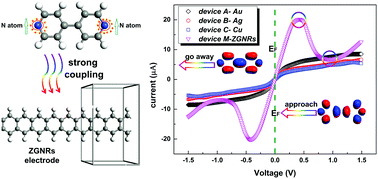Distinctive electron transport on pyridine-linked molecular junctions with narrow monolayer graphene nanoribbon electrodes compared with metal electrodes and graphene electrodes†
Abstract
The electrodes in the molecular devices are essential for creating functional organic electronic devices. We investigate theoretically the pyridine-terminated molecule – 4,4′-bipyridyl attached to the narrow monolayer zigzag graphene nanoribbon electrodes, compared to the metal (Au, Ag and Cu) and 2D graphene electrodes. Results show that this zigzag graphene nanoribbon-based junction shows excellent electron transport performances. It possesses great transmission at the fermi level due to the strongest delocalization of the electronic state. The coupling of the dominant molecular orbital to the ZGNR electrodes is much stronger than that to the metal electrodes due to a higher contributing proportion of PDOS on N atoms in the molecule at the fermi level. Also the molecular orbital couples more strongly to the ZGNR electrodes than the graphene electrodes because of a larger device density of state around the fermi level. Moreover, the different molecule–electrode coupling among these metal-based devices stems from the different proportion of density of d-states of the electrodes at the fermi level. In addition, the device with the narrow ZGNR electrodes exhibits the NDR effect unexpectedly.


 Please wait while we load your content...
Please wait while we load your content...